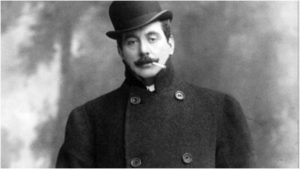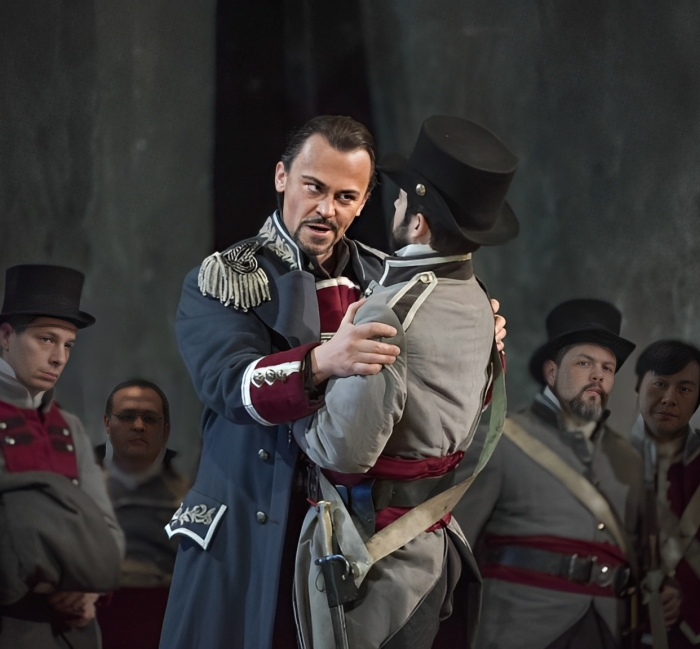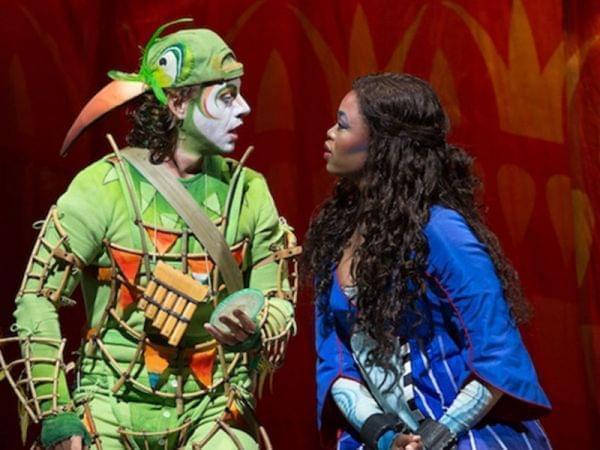
On This Day: A Deep Dive into Puccini’s ‘Le Willis’ on the Anniversary of His Stage Debut
By Bob DieschburgOn May 31, 1884 Puccini made an unlikely debut at Milan’s Teatro dal Verme. Despite an ad- hoc mounting of “Le Willis,” he gained the acclaim of both the public and critics, forcing the impresario Steffenoni to extend its run to three consecutive nights. “Clamorous success. Eighteen curtain calls. First finale repeated three times. Am happy” we hear the 25-year-old report to his mother.
Yet, this first success on the operatic stage was anything but guaranteed. His correspondence from the summer and fall of 1883 suggests that composition was slow and, as a recent graduate, he could rely on little more than the confidence of his former teacher – Amilcare Ponchielli – who encouraged his participation in the Concorso Sonzogno.
Rejection
This competition launched by the eponymous publisher proved a disappointment and Puccini did not even receive an honorable mention. Indeed much ink has been spilled over the very reasons for this denial, as the winning pieces of Guglielmo Zuelli and Luigi Mapelli had not much of a posterity. Why then was “Le Willis” rejected?
There has been speculation about the terms of the Concorso and Puccini interpreting them too freely. After all “Le Willis” was some sort of musical hybrid whose symphonic interlude had little in common with the teaching mainstream.
Similarly, his poor handwriting has been evoked as a fairly straightforward explanation for the course of events. Yet the score remains legible in its original parts and, as the Gazzetta Musicale pointed out, copyists had no trouble working on the material for the Dal Verme premiere.
What has recently been favored is an entirely different idea, involving Giulio Ricordi and his roguish cleverness in enrolling the avant-garde for his publishing firm.
Could Ricordi have manipulated the jury and hence the outcome of the competition? Be that as it may, the éminence grise among publishers had heard of the youngster even before a meeting was arranged in February of 1884; by then he was aware of Puccini’s talent.
However, from the perspective of his maturing over the years it becomes clear that we are far from the melodies, let alone the theatrical instincts of “Tosca” and “Madama Butterfly.” This gap is masked to some extent by the 1889 revision which has established itself as the go-to version of “Le Villi” – this time in two acts.
An Experimental Opera
It has indeed taken the editorial efforts of Martin Deasy and a benchmark recording from Opera Rara to restore the original sound of a piece that has literally turned into a palimpsest of changes and adaptations. At the same time it is needless to repeat the philological findings of Martin Deasy who has convincingly presented “Le Willis” as an experiment in scapigliatura aesthetics. He has thus rehabilitated the somewhat programmatic and clumsy libretto, putting the drama on par with its musical interpretation.
Of equal interest is the vocal writing and Puccini seems to attribute specific requirements or voice types to his main characters Anna and Guglielmo. With the unduly absence of a tenor solo they carry much of the plot’s emotional highlights; for instance, the baritone aria had its fair share of applause.
This is an interesting observation, as critics have continuously singled out the love duet and the preghiera as the opera’s most noteworthy moments. The orchestral postlude of the latter made an especially novel impression and Filippo Filippi, after the Scala premiere in 1885, reports thus:
“When the chorus is finished Roberto departs, and while Anna weeps, consoled by her father, inflamed sounds spring forth from the orchestra like a wave, so potent, so inspired, a phonic effect so novel that the audience remained enraptured by it, and wanted to hear once more the piece, and then another time, not only the first but the second evening.”
Whether this was the result of a no matter how innocent exercise in symphonic writing or a deliberate clin d’oeil towards the introduction of Wagnerism does not matter. It only helps to illustrate what is a striking contrast with the following aria.
“Anima santa” and its arioso are indeed reminiscent of the Verdian style with its high tessitura and dynamic variations; it proceeds with a vocal line revolving around the passaggio and, albeit on a different scale, the comparison with hallmarks like “Il balen” are not out of place.
And yet the Verdi baritone which typically invests a fatherly figure is strangely absent from the rest of Puccini’s oeuvre and potential contenders are relegated to secondary parts. The prime exponents, on the other hand, are characters with dubious morals that give the baritone interpreter ample opportunity to display his famous snarl and hardly are there better examples of this than the Scarpia of Tito Gobbi and Giuseppe Taddei.
Things are different with Guglielmo Wulff. His are decidedly lyrical inflections making him not only the carrier of our sympathies but also the tenor’s antagonist per se. This conception Puccini would never reiterate in his later works and one might wonder why.
After all, the tenor connotes the ideal and often juvenile lover who despite some occasional shortcoming remains the public’s favorite. Not so the baritone. In “Le Willis”, however, the latter is framing the drama by placing his plea for revenge within the general scheme of divine justice. Thus, Roberto is being killed by the dancing wraiths and Wulff closes the opera with his exclamation: “È giusto Iddio!”
Unfortunately, we barely know anything about the voice of Erminio Pelz (sometimes spelled Peltz) when he created the role in 1884. Reports about timbre and technique seem to be non- existent and the closest we come to an appreciation of his vocal means is a comment on his “voce robustissima” that the Gazzetta Musicale noted after a performance of “Salvator Rosa.”
The latter opera’s first Masaniello was Leone Giraldoni, a celebrated Verdian and one of the aging composer’s favorite baritones. Would it overstretch the imagination to think of the “voce robustissima” as similarly adept in the repertoire of “Il trovatore,” “Un ballo in maschera,” and even “Simon Boccanegra”?
However circumstantial the evidence Guglielmo Wulff does not belong into the aesthetic orbit of Puccini. What may have been an eclectic attempt at writing for the medium voice grows into a cutting down of the role’s prominence within the couple of months that separate “Le Willis” from its two-act revision at the end of 1884.
Soprano Queries
The case of the soprano is an altogether different one, feeding into the controversies over a psycho-analytic reading of the heroines in both the private and artistic lives of the Lucchese maestro. The argument goes back to Mosco Carner’s groundbreaking publication over half a century ago when he diagnosed an oedipal complex in Puccini that systematically leads to the death of his female protagonists, that is the lyric soprano.
There is certainly a good part of mythography in Carner’s reasoning that from a pseudo-clinical point of view makes the composer’s relationship to his mother look unsound. Similar theories have been elaborated with regard to his complicated and often unhappy marriage to Elvira Bonturi, the larger-than-life Erinys.
Are we to believe the conspirators, then Turandot and the Zia Principessa are the embodiment of the raging Elvira; she is the punishing dramatic voice that seeks constant retaliation for the amorous trespassing of her husband.
Methodology requires such an analysis to be taken with a grain of salt. It nonetheless reveals what is almost a Puccinian trope, namely the opposing dynamics of the female voice which at either end of the spectrum becomes a more or less rigid type. The lyric soprano is the sometimes feeble but generously loving voice of youth, whereas its dramatic counterpart dominates the action as a cold-blooded and enigmatic femme fatale prone to inflicting death.
This dichotomy is hardly a new one, but in perpetuating his stereotypes Puccini achieves a degree of almost radical consequence that is surprising even for the highly codified tradition of Italian opera. In “Le Willis” they come to a very peculiar realization, as the role of Anna needs to encompass both the soubrette and the revenant.
This constellation is unique among his creative output and Puccini will deliberately avoid returning to its most fundamental problem: the transformation of the soprano lirico or even leggiero into her polar opposite. That does not mean that the tessitura and vocal writing change and Anna’s resurgence does not hold any more difficulties than the beginning of the opera.
It is rather a question of matching the voice and its timbre with the most adequate means of expression; conversely, the female lead is expected to either be as versatile an interpreter as can be or to possess what are de facto two voices.
A brief look at the discographic fortunes of the piece confirms the above. A lyric soprano necessarily lacks the dramatic intensity of the wraith. A heftier singer, on the other hand, misses the sprezzatura of the young maiden – especially after the addition of “Se come voi piccina” in the two-act version.
What conclusions then did Puccini draw? Almost stepping back in his aesthetic demands, he created the personages of Fidelia and Tigrana which are the unsuccessful heirs to the original Anna. Yet “Edgar” received little attention and none of the arias have really integrated the concert repertoire, let alone established themselves in studio recitals. Neither Fidelia nor Tigrana are much of a breathing character.
Seen from a larger angle, however, the composer did go back to the transformation of a protagonist onstage. Turandot was meant to change after the prince made her ice melt away. Unfortunately, Puccini did not find a solution to the musical aporia the unlikely twist involved; he died in Brussels, leaving a notorious set of 36 sheets of unfinished music behind.
Coming back to the premiere of “Le Willis” and its immediate aftermath the role of Anna seems to have been pivotal for the opera’s success; different casting decisions reveal to what extent it depended on the credibility of the maiden-turned-demon while at the same time emphasizing a tendency towards favoring her dramatic side.
The first Anna was Rosina Caponetti-Bassi whose repertoire extended from Gilda to Leonora in “Il trovatore”. In 1885, she sang in Filippo Marchetti’s “Ruy Blas” and created the title role in the three-act piece “Maria” by Irene Morpurgo. We also find her in a performance of Lucia di Lammermoor which the Gazzetta Musicale termed “discreta”.
Similarly, her voice is deemed “simpatica” by the Teatro Illustrato and we search for more detailed assessments of her technical abilities in vain. Given her predominantly lyric roles we are thus tempted to recognize in Caponetti-Bassi an example of the lighter and juvenile Annas that are but moderately comfortable with the changed tone of the revenant.
Yet the two-act version premiered with Elena Boronat, an acclaimed Norma from the 1880 season in Rome and sister to the more famous Olimpia. On January 24, 1885 “Le Villi” finally reached La Scala and the score had by now come close to its definitive form. With Romilda Pantaleoni the role had found an exponent of the dramatic type whose career would take her to the creation of Tigrana only a couple of years later.
We may thus conclude that the balance had shifted and a fin mot – however temporary – was reached. Casting decisions had no less than compositional changes pushed the soprano part in “Le Willis” to the dramatic end of the emotional spectrum. It is indicative of the many struggles involved in reconciling polar opposites while giving some rare insight into the early reception of Puccini’s oeuvre.
As for contemporary recordings, none capture the Gothic sentiment better than the before mentioned production by Opera Rara and, for the two-acter, Radio France’s 2003 release under the direction of Marco Giudarini. Here we find an epigonal interpretation that, to understand the incepting genius, it is worth revisiting.
Categories
On This Day

